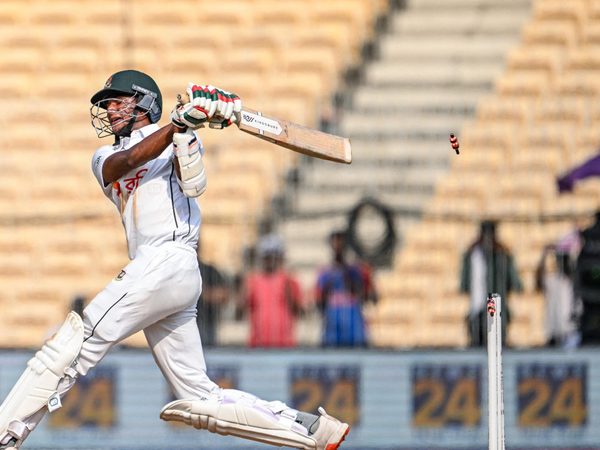
Chris Woakes has been selected in England’s Test squad to tour Pakistan next month after a two-and-a-half year overseas red-ball hiatus.
While the selection comes at the end of a successful summer for Woakes, in which he took 24 wickets across six games at 20.25, it’s nonetheless an eyecatching call. The disparity between Woakes’ record overseas and his performances at home are well documented, but are worth laying out.
In England, Woakes has taken 137 wickets at an average of 21.59 - only four English seamers with 50 wickets or more on home soil have taken their wickets at a lower average, and only one (Ollie Robinson) has done so this century. He is a genuine master in English conditions, skilled at exploiting movement on offer with the new ball and also as a change bowler, the position he operated in for most of his career while James Anderson and Stuart Broad took the fresh Dukes. However, when overseas his average jumps to 51.88 and he has just 36 wickets from 20 Tests outside England.
Bowlers being less effective in conditions which don’t suit them is not unusual. It’s normal that Woakes and England’s other seamers don’t get the same rewards they get in England, where the conditions and ball are more suited to low-mid 80mph seamers than anywhere else in the world. The problem is the scale of that difference in Woakes' case. At home, Woakes is up there with England’s best ever. Away he is statistically one of their worst.
Taking into account only England seamers who have bowled in 10 innings away from home over their career, and eliminating those for whom bowling wasn’t their primary skill (eg. Jonathan Trott), only five have a worse overseas average than Woakes. It’s stats like these which have been hanging over Woakes for a large part of his career, and made his position in the side less stable between winter and summer.
He wasn’t selected for England’s tour of India earlier in the year, despite his resurgence during the previous summer’s Ashes. At the time, Woakes admitted the decision was “fair” and referred to his age (now 35) and overseas record as reasonable justification. Given that England’s selectors were at ease leaving him out for India, they seem to have had a drastic change of opinion over the last six months.
England have named a 17-strong squad for their Test tour of Pakistan next month ✈️
— Wisden (@WisdenCricket) September 10, 2024
Jack Leach returns, Chris Woakes is retained and Brydon Carse receives a first call-up.
Read more ➡️ https://t.co/l6nIpdJ0Qh pic.twitter.com/llYUUnLs8z
In part Woakes’ selection could be justified from an experience point of view. The other five specialist seamers selected - Olly Stone, Matthew Potts, Gus Atkinson and Josh Hull - have one overseas Test cap between them. Now unable to rely on James Anderson’s brilliance and experience as they did last time out in Pakistan, on what were extremely flat pitches, Woakes has assumed the role of the attack's veteran.
Equally, Woakes is very difficult to replace in the XI, especially given that England have not picked the spinning all-rounders they did in 2022. He is an incredibly important option to have in the side at No.8 and, although Atkinson stepped up at Lord’s this summer, their lower-middle order looked light against Sri Lanka. The squad England have selected suggests they will go with two specialist seamers and two specialist spinners in their XI. Woakes coming in at No.8 means that England won’t have to play either of their inexperienced all-rounders, Rehan Ahmed or Brydon Carse, or promote Atkinson to No.8 if they don't want to. Should Stokes not recover in time, Woakes is also an option at No.7.
But perhaps most importantly, just how good Woakes has been across the last two summers must have twisted England’s arm into giving him one more go overseas. Woakes has taken more wickets at a better average than every other England bowler across those two summers, and only Robinson and Anderson - one retired one no longer in the picture - have better economies. Woakes is bowling better than he’s ever bowled. Surely that could translate into an upturn overseas as well?
That being said, his selection, and that of an all-changed pace attack, marks a substantial difference from the way England approached the 2022 Pakistan series. Two years ago, Anderson and Robinson’s brilliance, as well as bursts of Mark Wood’s raw pace were a vital part of that historic series win. This time, England won’t have that express pace, nor will they have the relentlessness, accuracy and variation that Robinson and Anderson offered.
Instead, Woakes will probably be used to extract movement and for his durability to bowl spells throughout the day, while Atkinson and Stone get any bounce on offer out of the surfaces. While Hull is still relatively unknown, young and inexperienced, his height and angle in those kinds of conditions could also be useful. Woakes' development of a wobble-seam delivery could also be important in increasing his threat level. Equally, the pitches could well be different to the roads England were faced with in 2022. In Pakistan’s recent Test against Bangladesh in Rawalpindi - where England scored 506 runs on day one two years ago - conditions favoured both sides’ seamers.
This recall might be Woakes’ last chance to sweeten the memories of his overseas outings. Earlier this summer, he cited Anderson’s upwards trajectory as he entered his late thirties as something he wanted to emulate, potentially extending his shelf life to the Ashes in Australia next winter. The tour in Pakistan will be a key opportunity to prove he’s worth another go before then.
Follow Wisden for all cricket updates, including live scores, match stats, quizzes and more. Stay up to date with the latest cricket news, player updates, team standings, match highlights, video analysis and live match odds.








